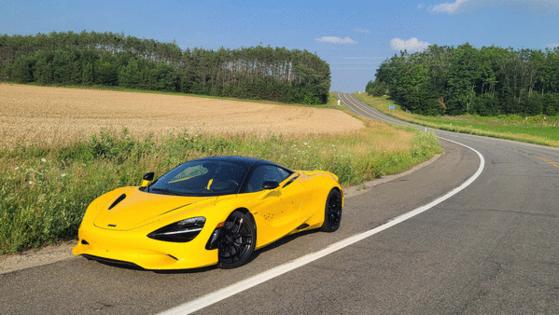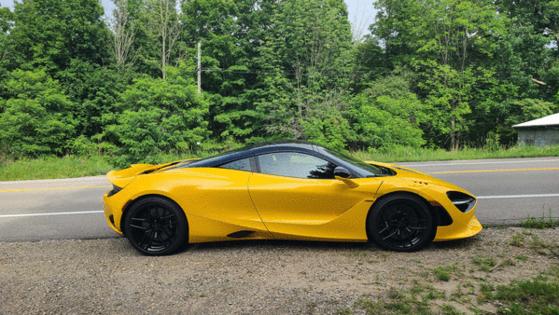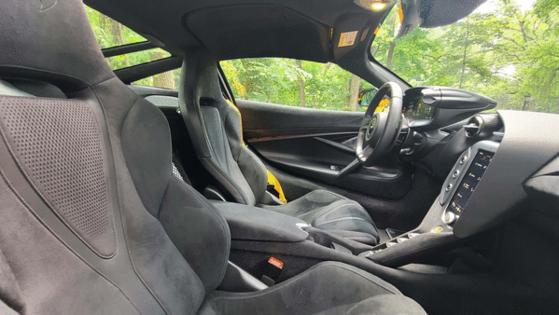Auto review: My date with a McLaren 750S supermodel supercar
Published in Automotive News
CHARLEVOIX, Michigan — Mat the brake pedal. Press LAUNCH control. Mat the accelerator pedal. Wait for RPM to level at 3,000. Dump the brake.
Foom!
My 2025 McLaren 750S rocketed past 60 mph in 2.3 seconds. 100 mph? Just 4.8 seconds. At which point the mighty 4.0-liter, twin-turbo V-8 behind my ear was just clearing its throat. WAAUUUGGGGHH! You probably heard the blood-curdling howl all the way down in Detroit. For relevance, you have to delve into the realm of motorsport. Launching the 750S nearly approximates a McLaren Formula One car, which hits 60 mph in 1.6 seconds and 100 in 2.6. (OK, that last figure is just insane. But the 750S hits 100 mph in the same amount of time it takes a Porsche Cayman to get to, ahem, 60.)
And thanks to the Netflix “Drive to Survive” series, everyone knows McLaren.
Like the 750S in Launch mode, Formula One has rocketed to prominence in the United States, making the British company and its ace drivers, Lando Norris and Oscar Piastri, household names. This is McLaren’s U.S. moment. For decades one of the top teams in international motorsport, it has produced exceptional production cars: the P1, MP4, even the 750S’s predecessor, the 720S. Now as F1’s best team, McLaren’s V8-powered 750S, Artura and GTS production lineup gets to share the American spotlight.
Think Ferrari in the 1960s as its motorsports dominance made legends of the V12-powered 250 GTO, 275 GTB and 400 Superamerica sports cars.
The 750S is every bit as deserving.
Powered by a 740-horse (the 750 number comes from the metric, so-called “Pferdestärke” or “PS,” calculation of horsepower) V-8 strapped to a carbon-fiber, monocoque chassis, the McLaren is a race car in drag.
An evolution of the 720S I reviewed in 2018, 750S has made significant gains, including 30 more horsepower, 30% new parts, 20% more rear wing, center-mounted exhaust, 66 less pounds of body fat. You’ll know it by its aggressive front spoiler. Previous McLarens I’ve tested (720S, 570S, Artura) turned heads, but with McLaren’s new-found U.S. fame, my drive up I-75 was like a trip down the red carpet.
Supercar supermodel.
Camera phones popped out of windows to record it. Vehicles lingered beside me at 80 mph. A trucker trailering a dirt-track racer waved me down and we exchanged thumbs-up. Parked with its batwing doors up, the 750S attracted passersby who snapped photos, asked questions, gawked.
That’s a McLaren!
It’s the 750!
McLaren is my son’s favorite F1 team! Can I take a picture in the driver’s seat for him?
Good lord, it’s beautiful!
I’m selling my house and buying one.
Dressed in yellow with a black greenhouse and headlight sockets, my tester 750S looked like a wasp. Underneath, it packs serious sting.
Its carbon chassis construction mirrors that of F1, IndyCar and IMSA hypercars. Only a few production cars — the Alfa Romeo 4C, Ford GT, Maserati MC20 — boast similar construction. The exotic material makes for stiff, lightweight body construction.
Weighing just 3,206 pounds, the 750S posts a power-to-weight ratio of 1:4. Replace the massive, show-car scissor doors and 750S would be lighter still. Corvettes’ 3,666-pound rear-wheel drive ZR1 supercar (an engineering marvel in its own right) requires 1,064 horsepower to record a better, 1:3.6 power-to-weight ratio.
The Mac feels like an oversized slot car.
Exiting the I-75 red carpet at Gaylord, I headed west on M-32, one of the state’s best driver’s roads. With little body roll, my steed changed directions instantly through S turns and diving sweepers — not unlike my monocoque-chassis, 1,350-pound Lola race car.
Unlike my small-displacement 2.0-liter Lola (power to weight ratio 1:9), the McLaren explodes off corners. The car’s unique shoulder line (sweeping back from those headlight sockets that double as oil coolers) is functional, feeding a river of air to the hungry mill behind me. Between turns, the 750S inhaled M-32’s straightaways, punctuated by massive brakes hauling the missile back to earth. Race car-like brakes for race-car like speeds.
Give this car a cape. With Superman in theaters, the 750S supercar begs the comparison. Its otherworldly capabilities quickly outgrow mortal roads, even on P-Zero summer tires. If Superman needs the sky, then the McLaren needs a racetrack to explore its envelope.
For all its superpowers, 750S is as normal as Clark Kent in daily driving (gawkers aside). The same hydraulic, lightweight adaptive suspension that firms the 750S in TRACK mode makes COMFORT mode smooth. The seven-speed gearbox shifts like butter. Ergonomics are superb with easy-to-reach stalks sprouting from the steering wheel. Even DRIVE modes are controlled by rocker switches just above the steering wheel on either side of the motorcycle-like digital instrument display.
At 6’5”, I had plenty of headroom in the supportive Alcantara seats, with Honda CR-V-like visibility. Other mid-engine cars require camera mirrors, given their thick C-pillars. Like a Porsche, 750S had a frunk for my laptop case and a rear-cabin shelf for a clothes bag. Got golf clubs? Buy a Corvette.
McLaren has kept the console simple, which should help avoid electronic glitches. But who needs an infotainment system when you have McLaren’s glorious V-8 choir behind you?
I never turned on the radio.
The race car cabin’s biggest sacrifice is footwell space. I have to stuff my size 15 feet into 11½ racing boots in my race car. In the McLaren, I needed narrow race boots or tennis shoes to operate the pedals. Drivers with normal dogs will be fine.
With its F1 success and hot production models, could McLaren become legend? In the late ‘60s, as Ferrari was gaining notoriety in the United States, the 275 GTB sold for $12,000. Some 25 years later, they auction for $3 million. Will McLarens be similarly coveted some day? A few driver titles by Lando Norris wouldn’t hurt.
One thing the 750S has that F1 cars don’t is a V-8 soundtrack. As F1 has moved toward a 50/50, gas-electric hybrid era, its V-6 engines have underwhelmed. There’s talk of moving away from costly, heavy batteries toward synthetic fuels. Should synfuels become viable, F1 teams like Cadillac and McLaren could use V-8 engines like those found in their production cars.
Imagine the howl. WAAAUUGGHGHR! We can only dream.
2025 McLaren 750S
Vehicle type: Rear-wheel-drive, two-door, two-passenger supercar
Price: $349,500, including $5,500 destination charge ($420,280 as tested)
Powerplant: 4.0-liter, twin-turbocharged V-8
Power: 740 horsepower, 590 pound-feet of torque
Transmission: Seven-speed, dual-clutch automatic
Performance: 0-60 mph, 2.3 seconds (Car and Driver); top speed, 206 mph
Weight: 3,206 pounds
Fuel economy: EPA estimated 15 mpg city/19 mpg highway/17 combined
Report card
Highs: Supercar supermodel; carbon chassis
Lows: No Android Auto; costs as much as a house
Overall: 4 stars
____
©2025 www.detroitnews.com. Visit at detroitnews.com. Distributed by Tribune Content Agency, LLC.













Comments